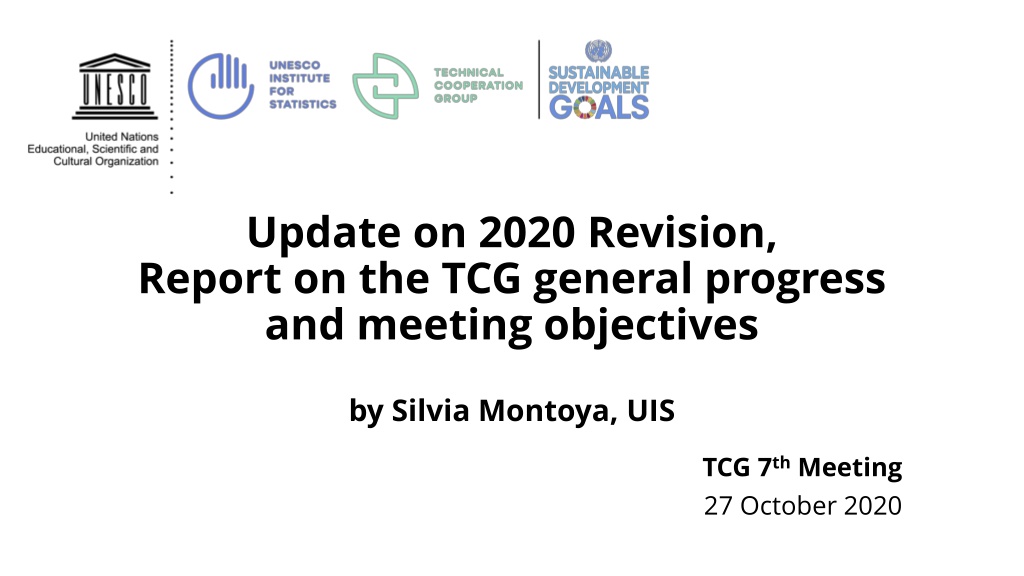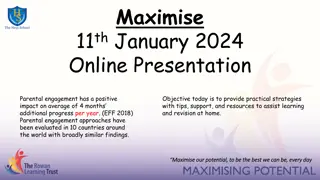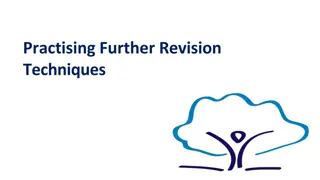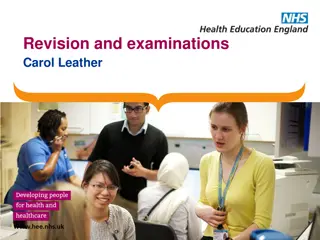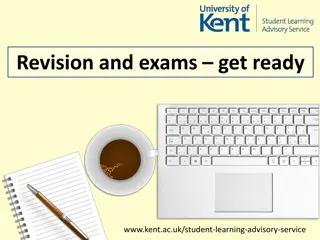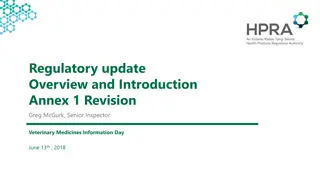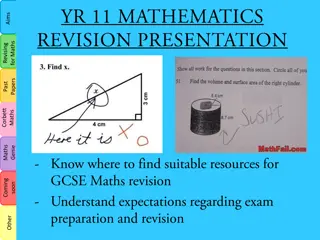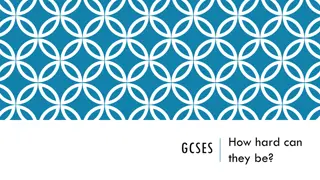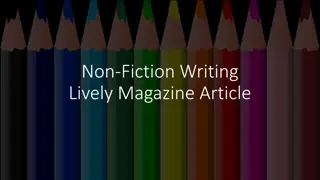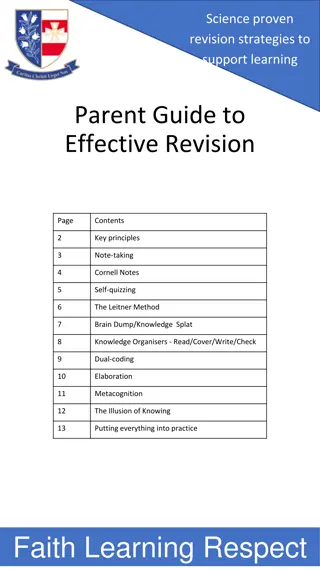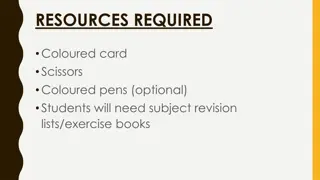TCG Report on 2020 Revision Framework
Update on 2020 Revision Framework and SDG4 Global Framework progress, including tiers and indicators. Role of UIS and GEMR in monitoring SDG 4. Impact of Technical Cooperation Group (TCG) on steering committee functions.
Download Presentation

Please find below an Image/Link to download the presentation.
The content on the website is provided AS IS for your information and personal use only. It may not be sold, licensed, or shared on other websites without obtaining consent from the author.If you encounter any issues during the download, it is possible that the publisher has removed the file from their server.
You are allowed to download the files provided on this website for personal or commercial use, subject to the condition that they are used lawfully. All files are the property of their respective owners.
The content on the website is provided AS IS for your information and personal use only. It may not be sold, licensed, or shared on other websites without obtaining consent from the author.
E N D
Presentation Transcript
Update on 2020 Revision, Report on the TCG general progress and meeting objectives by Silvia Montoya, UIS TCG 7thMeeting 27 October 2020
Update on 2020 Revision Framework The Inter-Agency and Expert Group on Sustainable Development Goal Indicators (IAEG) established at the 46thof the Statistical Commission The General Assembly, resolution 70/1 mandated the global indicator framework, to be developed by the IAEG-SDG to be agreed by the Commission by March 2016. UNSC decision 47/101, agreed, as a practical starting point subject to future technical refinement. A Workplan for examining a list of possible additional indicators and approved the revision framework was approved in the ToRs of the IAEG-SDG in 2017. The global indicator framework was adopted by the General Assembly in 2017 (A/RES/71/313) Session 1.c
SDG4 Global Framework the Roadmap to 2020 Initial Tier Classification: - Tier I: 3 indicators (4.2.2, 4.b.1, 4.c.1) IEAG-SDG - Tier II: 4 indicators (4.2.1, 4.3.1, 4.4.1, 4.6.1) - 4.1.1 upgraded from Tier II to Tier I - Tier III: 2 indicators (4.1.1, 4.7.1) - 4.5.1 Tier III removed (Tiers I/II stay) 4.1.1 b and c upgraded to Tier II Refinement: 4.7.1, 4.c.1 4.1.1.a Updated from Tier III to Tier II - Combination of Tiers: 2 (4.5.1 Tiers 1/II/III, 4.a.1 Tiers I/II) - 4.7.1 upgraded from Tier III to Tier II Final approval expected during UNSC-52nd session 4.2.2 upgraded to Tier I WebEx Meeting IEAG- SDG 3rd Meeting IEAG-SDG 5th Meeting IEAG-SDG 8TH Meeting IEAG-SDG Apr/2020 Apr/2016 Mar/2017 Nov/2018 Nov-Dec/2019 4th Meeting IEAG-SDG 6th Meeting IEAG-SDG 9th meeting IEAG-SDG UNSC - Mar/2020 Status as of Jul/2020 Nov/2016 Nov/2017 May/2018 4.2.1 downgraded to Tier III 4.2.1 Multi-tier indicator (Tier II/III), with the Tier II portion of the indicator referring to children 24-59 months of age 51st UNSC approves: - Tier I: 4 indicators (4.1.1, 4.1.2, 4.2.2, 4.b.1) 4.c.1 downgraded to Tier II - 4.1.2 (Completion rate) as global indicator for SDG Target 4.1 4.2.2 downgraded to Tier II - Tier II: 7 indicators (4.2.1, 4.3.1, 4.4.1, 4.6.1, 4.7.1, 4.a.1, 4.c.1) 4.a.1 downgraded to Tier II - Refinements: 4.2.1, 4.7.1, 4.a.1, 4.c.1 - Tier III: none - Combination of Tiers: 1 indicator (4.5.1 Tiers 1/II) Session 1.c
TCG Report the 2020 Revision Framework Paragraphs 97-103 of the Framework for Action describe the role of the UNESCO Institute for Statistics (UIS) and the Global Education Monitoring Report (GEMR) in supporting the monitoring, follow-up and review functions of the Steering Committee based on the SDG 4 global and thematic monitoring frameworks. In 2016 Technical Cooperation Group on SDG 4 indicators was established The TCG is composed of regionally representative Member States and international partners, including civil societies. In 2017, the UIS sent the framework to UNSC and update on progress is part of the bi-annual reporting. Session 1.d
TCG Members Session 1.d
TCG SDG4 Indicators Our 2016-2020 Roadmap - Reporting: 33 indicators - Reviewing Methodological development - Methodological development: 4.1.1, completion rate (4.1.2), OOSC (4.1.4), 4.2.3, 4.2.4, 4.3.1, 4.4.3, 4.5.2, 4.a.1(d) Institutional: Organization of the TCG and work proposal, I - Reporting: 29 indicators - Covid-19 response - Methodological development: 4.7.2, 4.a.2, 4.3.1, 4.6.3, 4.b.2, 4.2.3, 4.7.1, 4.5.2, 4.5.3, 4.a.3 -Benchmark implementation IAEG-SDGs global indicator proposal; Proposal thematic set of indicators - Results of Benchmark Consultation -Expansion of TCG membership TCG1 - Washington DC TCG3 Montreal TCG5 Mexico TCG7 Webinar May 2016 Jun 2017 Nov 2018 Oct 2020 TCG2 Madrid TCG4 Dubai TCG6 Yerevan Oct 2016 Jan 2018 Aug 2019 - Reporting 37 indicators - Reporting: Placeholders/Indic - Reporting 33 indicators - 4.7.4, 4.7.5, 4.5.2 - Methodological development: Metadata for SDG4 indicators 4.a.2, 4.a.3, 4.6.3, 4.7.2 Methodological development: monitoring education and equity, 4.2.3, 4.3.1, 4.5.2, 4.5.3, 4.6.3, 4.7.1, 4.7.2, 4.a.2, 4.a.3 -Methodological development: benchmarks, 4.1.1, 4.1.2, 4.1.5, 4.3.1, 4.4.3, 4.5.2, 4.5.3, 4.7.1, 4.7.4, 4.7.5, 4.a.1, 4.c.1, 4.c.3, 4.c.5 - Deletion: 4.b.2 Benchmarking discussion - Institutional: Global Coalition for Education Data (invite other organizations to contribute) Session 1.d
TCG meeting 2020: finalizing indicator development Indicators not reporting Indicator 4.5.3 Indicator 4.c.7 (today reduced to only OECD countries) Indicator 4.c.5 on teachers Indicator 4.7.3 on Human Rights Indicator on breadth of skills Increase coverage and data use Refine indicators as needed Develop strategies for covering data gaps to be filled and almost immediately available information Increase the use of less traditional sources for data collection Session 1.e
Education 2030 Framework for Action Called oncountries to establish appropriate intermediate benchmarks (e.g. for 2020 and 2025) for the SDG indicators, seeing them as indispensable for addressing the accountability deficit associated with longer-term targets ( 28) Consultation process Political commitment: Benchmarks need to be feasible and based on national ownership. Define benchmarks at regional level: common challenges and more opportunities to enter into policy dialogue Technical issues: Measurement issues to resolve Session 1.e
Political process Involve regional organizations to achieve alignment between global and regional education agendas and avoid duplication; and: confirm willingness to support a benchmarking process coordinate with organizations where memberships overlap identify steps leading to approval of benchmarks Two aspects of flexibility in the process: any regional organization willing to lead the process can do so regional organizations may set additional benchmarks Session 1.e
Covid-19 Response Regional webinars and a dedicated webpage to COVID-19 Joint Survey on School Closures : a country-level survey of to monitor national education responses to COVID-19 school closures jointly with UNICEF and World Bank Group (WBG) o1st iteration: 118 countries across 8 regions (15 April 2020 - June 12, 2020 o2nd iteration: 149 countries (15 July 2020 - 15 October 2020) Survey to Planning Units a survey designed for Statistical Planning Units in Education to monitor COVID-19 pandemic impacts on national education planning units. o 129 countries across 9 regions Other Initiatives oInter-Secretariat Working Group on Household Surveys (ISWGHHS), COVID- 19 task force: co-chair with WBG oUN Wide effort on the impact of COVID Session 1.e
